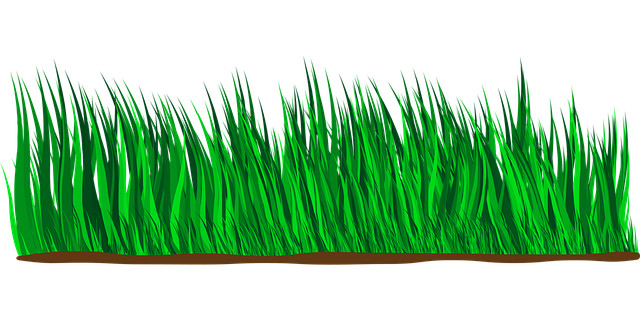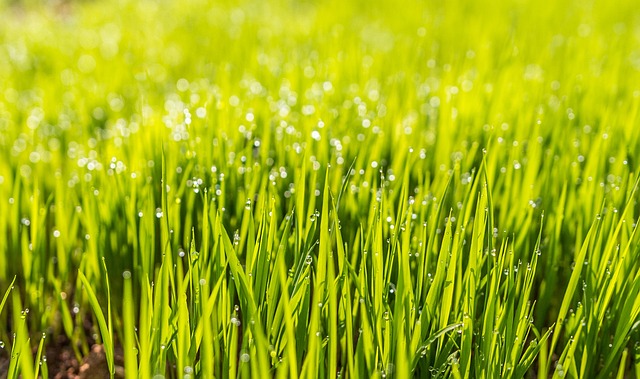Effective lawn care and landscaping hinge on a strategic fertilization plan tailored to your grass type and soil conditions, with optimal N-P-K ratios ensuring robust growth and resilience. A scheduled fertilization program, typically with spring and fall applications, is crucial for supporting the grass's growth cycle and preparing it for seasonal changes. Weed control is equally vital, requiring a proactive approach that combines fertilization with targeted herbicide use to maintain a lawn free of unwanted vegetation. Homeowners should select the right fertilizer for their grass type and local climate, considering organic options for long-term soil health. Additionally, understanding your lawn's weed profile and employing both pre-emergent and post-emergence herbicides will help your grass outcompete weeds, contributing to a healthy, green landscape that reflects a commitment to lawn care and landscaping excellence. A year-round approach with a four-application fertilization schedule customized to the local growing season is recommended by professionals for achieving and maintaining a lush lawn that can endure environmental challenges and remain less susceptible to weeds. Lawn Care and Landscaping practices are essential for transforming your outdoor space into a vibrant, resilient, and aesthetically pleasing area throughout the year.
Maintaining a lush, green lawn is a cornerstone of picturesque landscaping and a testament to meticulous lawn care. A well-fertilized lawn not only bolsters the health and resilience of your grass but also acts as a natural barrier against unwanted weeds. This article delves into the synergy between effective fertilization and targeted weed control, offering insights into understanding the fundamentals of lawn fertilization, identifying the right nutrients for your turf’s needs, and mastering the timing and methods to optimize growth. We will also explore various strategies for controlling weeds, from organic solutions to pre-emergent and post-emergent treatments, ensuring that your lawn remains a vibrant feature in your landscaping endeavors. Balancing these practices will lead to a harmonious lawn ecosystem, enhancing both the aesthetic appeal and overall health of your lawn year-round.
- Understanding the Fundamentals of Lawn Fertilization
- – The Role of Nutrients in Maintaining a Healthy Lawn
- – Choosing the Right Fertilizer for Your Lawn's Needs
- – Timing Your Fertilization for Optimal Growth and Vigor
Understanding the Fundamentals of Lawn Fertilization

A well-maintained lawn is a hallmark of meticulous lawn care, and understanding the fundamentals of lawn fertilization is pivotal to achieving this. Fertilization is not merely about spreading nutrients; it’s a strategic process that involves selecting the right type and amount of fertilizer for your grass species and soil composition. The primary goal of lawn fertilization is to provide essential nutrients like nitrogen, phosphorus, and potassium, which are vital for healthy turf growth. These nutrients support leaf development, root expansion, disease resistance, and overall vigor. Landscaping professionals often recommend a comprehensive fertilization schedule that aligns with the growth patterns of your grass. This typically includes both a spring application to promote strong growth after winter and a fall application to prepare the lawn for dormancy, ensuring it stores enough energy to survive the cold months and bounce back vigorously in the spring.
Incorporating weed control measures in conjunction with fertilization is another critical aspect of effective lawn care. Weeds can quickly overtake a lawn if not managed properly, competing with desirable grasses for sunlight, water, and nutrients. Pre-emergent herbicides are applied to prevent weed seeds from germinating, while post-emergent treatments target existing weeds. The timing of these applications is crucial and should be coordinated with the fertilization schedule to create an environment that favors grass over weeds. By understanding the fundamentals of lawn fertilization and integrating it with effective weed control strategies, homeowners can maintain a lush, healthy lawn that stands as a testament to their dedication to landscaping excellence.
– The Role of Nutrients in Maintaining a Healthy Lawn

– Choosing the Right Fertilizer for Your Lawn's Needs

When addressing the health and appearance of your lawn, selecting the right fertilizer is a pivotal aspect of effective lawn care and landscaping. The choice of fertilizer depends on several factors, including your grass type, regional climate conditions, and soil composition. For cool-season grasses, such as Kentucky bluegrass or fescue, a fall and early spring application of a nitrogen-rich fertilizer will promote root growth and vibrant green color. Conversely, warm-season grasses like Bermuda grass or Zoysia do best with fertilization in late spring through summer when they are actively growing. A balanced N-P-K (nitrogen, phosphorus, potassium) ratio is essential for overall lawn health; however, the specific ratio may vary based on the needs of your particular turf. It’s crucial to read and follow the product labels for application rates and timings tailored to your local conditions. Additionally, organic options like compost or fish emulsion can offer a slower-release nutrient source, contributing to long-term soil health as part of an integrated lawn care and landscaping program.
In conjunction with choosing the right fertilizer, understanding your lawn’s weed profile is equally important in maintaining a lush, green landscape. Different types of grasses can be susceptible to different weeds; therefore, it’s essential to identify which weeds are prevalent in your region and target them effectively. Pre-emergence herbicides can prevent weed seeds from germinating, while post-emergence treatments manage existing weed populations. A well-timed pre-emergence application in the spring followed by a post-emergence treatment as needed throughout the growing season will create an environment where your grass can thrive without competitive weeds. Integrating these practices into your lawn care and landscaping routine will not only enhance the aesthetic appeal of your lawn but also contribute to its resilience against weed invasions.
– Timing Your Fertilization for Optimal Growth and Vigor

For homeowners looking to maintain a lush, vibrant lawn, understanding the optimal timing for fertilization is crucial for encouraging healthy growth and ensuring lawn vigor throughout the year. The key to successful lawn care lies in aligning your fertilization schedule with the specific growth patterns of your grass type, which varies by climate and region. During the early spring, as temperatures rise and the soil begins to warm, applying a balanced fertilizer with a higher nitrogen content promotes leaf growth and root development, setting the foundation for a thick, dense lawn that can outcompete weeds. In the late fall, after the grass has ceased active growth but before the ground freezes, a winterizer fertilizer should be applied. This type of fertilizer is formulated to supply nutrients that are absorbed slowly, ensuring the grass has the necessary reserves to survive the cold months and bounce back with greater resilience in the spring. Landscaping professionals often recommend a routine fertilization schedule divided into four applications throughout the year, tailored to the local growing season, to provide consistent nutrition and support overall lawn health. By following this regimen, your lawn care efforts will be rewarded with a robust, green, and weed-resistant lawn that stands up to the elements and thrives under proper management.
In conclusion, a well-maintained lawn serves as an enviable expanse of greenery that enhances both the aesthetic appeal and value of any property. Effective lawn care and landscaping hinge on a solid understanding of the fundamentals of lawn fertilization and the strategic application of weed control measures. By selecting the appropriate nutrients and fertilizers tailored to your lawn’s specific requirements, homeowners can foster a robust and resilient turf. Timing the application of these nutrients is critical for stimulating optimal growth and ensuring your lawn remains verdant and vibrant throughout the seasons. With diligent attention to these practices, you can achieve a lush, healthy lawn that stands as a testament to meticulous lawn care and landscaping efforts.






